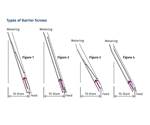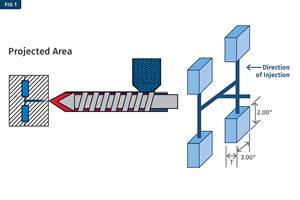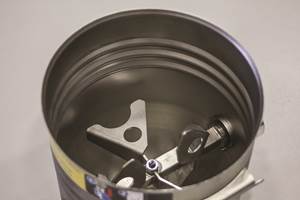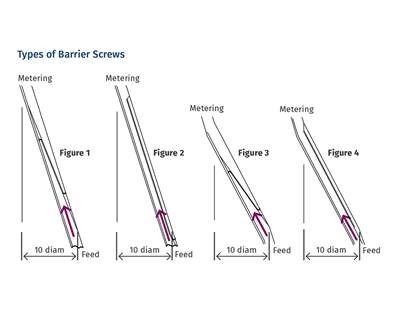Don’t Build In Melt-Temperature Variations
It’s not unusual for polymer to exit the extruder with a uniform melt temperature, only to be fouled up by downstream flow pipes and the like. Here’s how to avoid this.
Quality extrusions are judged primarily by their dimensional tolerances. Getting consistent tolerances requires steady output and uniform melt temperature throughout the extrudate. This yields uniform flow, drawdown, and shrinkage.
It’s not unusual to have a relatively uniform melt temperature leaving the extruder and/or screen changer and then have a substantial temperature difference “built into” the melt through the flow pipes and other downstream apparatus leading to the die. The longer the downstream apparatus and the lower the flow velocity, the more variation that can be built in.
In a previous column (March 2010), I discussed the degradation that can occur due to low flow velocity. The same factor can build in variation in melt temperature, which influences die-flow stability, particularly in thin cross-sections and thin coextrusion layers. These variations are often blamed on poor screw design, and operators typically respond by increasing screen-pack density. But that approach actually adds to the melt temperature, reduces the output, and offers no improvement. Sometimes it makes matters worse.
Figures 1-4 show flow velocity in a round flow orifice. The output in any area is proportional to the velocity, so what is really revealed is the variation in output across the cross-section.
Polymer flow is always laminar or layer-like because of the high viscosities, so pressure flow in a round pipe is essentially in concentric rings around the center. The highest flow always occurs in the center of the pipe, with decreasing flow velocity as the distance increases from the center. Since the polymer sticks to the walls of the orifice, the velocity is zero at the walls and maximum at the center. The hotter polymer—having a lower viscosity—moves to the geometric center of the flow area, where shear stress from the drag on the walls is minimal.
Figure 1 shows an ideal flow velocity. The flow approaches plug flow, and the velocity is pretty uniform, although still zero at the walls. This is an ideal design but cannot always be implemented for a variety of reasons. Figure 2 shows a more typical situation, where the flow orifices are oversized to control pressure or the output is reduced for other reasons. Figure 2 is what would be expected in an isothermal condition at about half the potential for plug flow.
In Fig. 3, the orifice walls are at a substantially lower temperature than the melt entering the orifice. This results in a more concentrated center flow with a higher velocity, and a larger area of the orifice filled with slower to very-slow-moving polymer. This results in a greater variation of melt temperature entering the die and is a poor operating choice. This is often a result of assuming the melt can be cooled in that way, but that either has no effect or actually increases the melt temperature because of the increased pressure drop due to the reduced flow area. Polymers are excellent insulators, and trying to cool them in laminar flow at the wall is very ineffective.
Figure 4 is a condition where the wall is at an equal or higher temperature than the melt. Any maintenance or even slight heating of the melt near the wall reduces the viscosity near the wall and the overall shear stress in the melt flow, which enlarges the flow area.
Personally, I find that setting the flow pipes and downstream apparatus 10° F higher than the melt temperature exiting the extruder is a good starting point, until more information is available. The more uniform the flow, the more consistent the melt temperature. It is important to minimize variation in temperature through the extrudate, as variation will affect the die flow and dimensions of the final part. A lot of this can often be mitigated by use of a static mixer, which should always be located as close to the die as possible so that no further variation can be built in after the mixer. Of course, proper design and thermal control of the downstream apparatus is a solution in itself that provides a narrow window where operation is near optimum.
ABOUT THE AUTHOR: Jim Frankland is a mechanical engineer who has been involved in all types of extrusion processing for more than 40 years. He is now president of Frankland Plastics Consulting, LLC. Contact jim.frankland@comcast.net or (724)651-9196.
Related Content
Is There a More Accurate Means to Calculate Tonnage?
Molders have long used the projected area of the parts and runner to guesstimate how much tonnage is required to mold a part without flash, but there’s a more precise methodology.
Read MorePart 2 Medical Tubing: Use Simulation to Troubleshoot, Optimize Processing & Dies
Simulation can determine whether a die has regions of low shear rate and shear stress on the metal surface where the polymer would ultimately degrade, and can help processors design dies better suited for their projects.
Read MoreInjection Molding: Focus on these Seven Areas to Set a Preventive Maintenance Schedule
Performing fundamental maintenance inspections frequently assures press longevity and process stability. Here’s a checklist to help you stay on top of seven key systems.
Read MoreFive Quick Steps Toward Better Blending
Rising costs of resins and additives, along with higher demands for quality and use of regrind, place a premium on proficient blending. Here are some steps to get you there.
Read MoreRead Next
Which Barrier Screw for You?
It depends ... mostly on the melting requirements of the polymer.
Read MoreFor PLASTICS' CEO Seaholm, NPE to Shine Light on Sustainability Successes
With advocacy, communication and sustainability as three main pillars, Seaholm leads a trade association to NPE that ‘is more active today than we have ever been.’
Read MoreSee Recyclers Close the Loop on Trade Show Production Scrap at NPE2024
A collaboration between show organizer PLASTICS, recycler CPR and size reduction experts WEIMA and Conair recovered and recycled all production scrap at NPE2024.
Read More.jpg;width=70;height=70;mode=crop)









